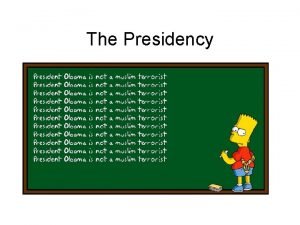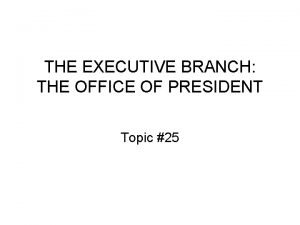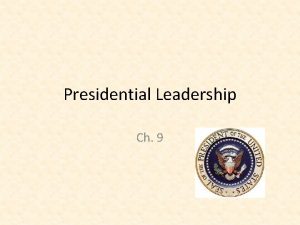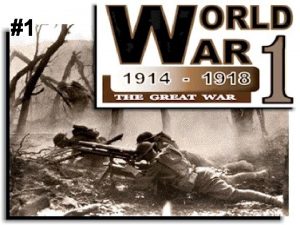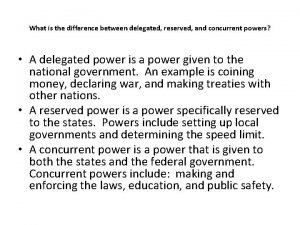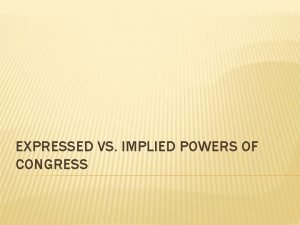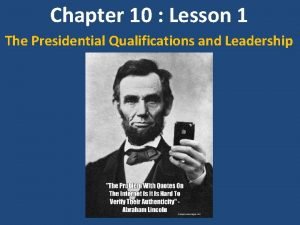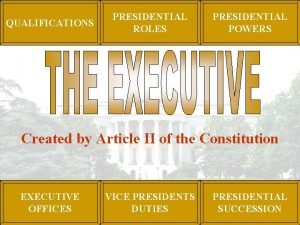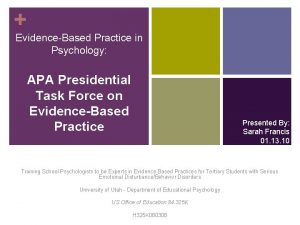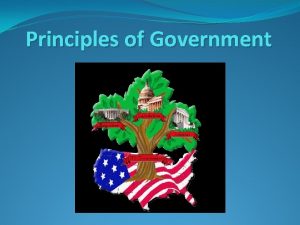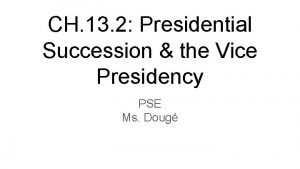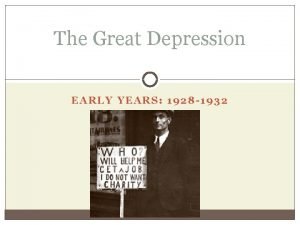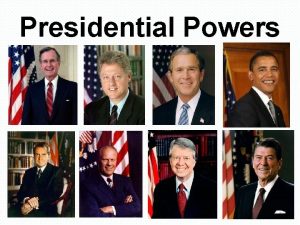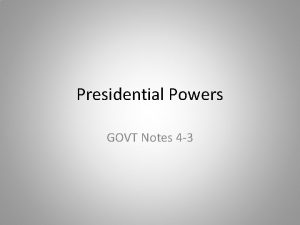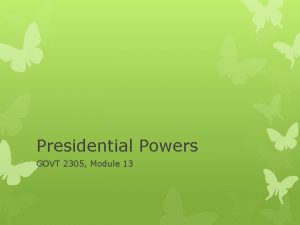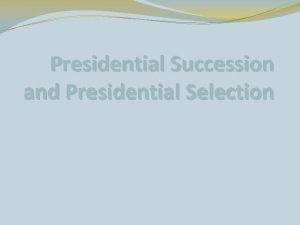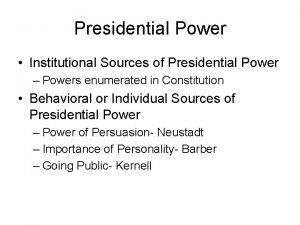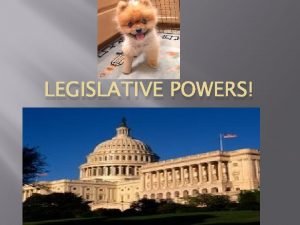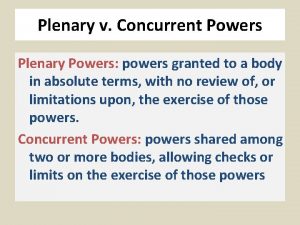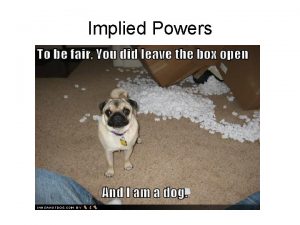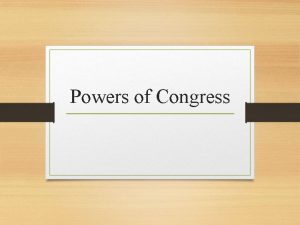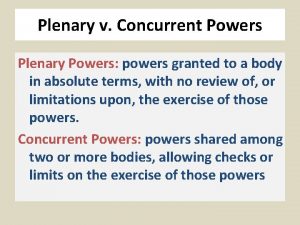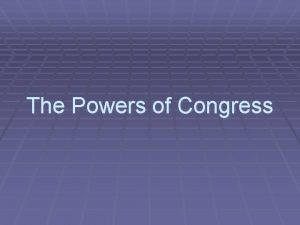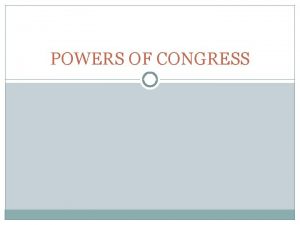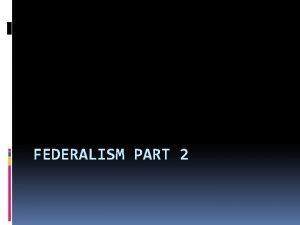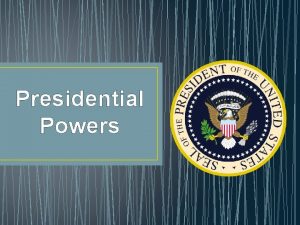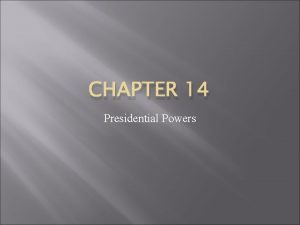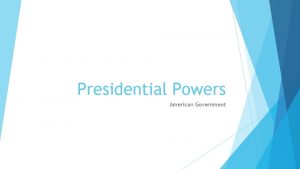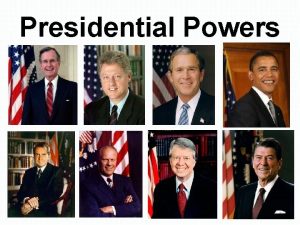Presidential Leadership Ch 9 Sources of Presidential Powers





















- Slides: 21

Presidential Leadership Ch. 9

Sources of Presidential Powers Lesson 1

The Constitution is broad but vague when it comes to the powers of the President. It says “that the executive power of the nation will be vested in a president”

Constitutional Powers Two major reasons for a strong executive government -The founders recognized the need for a strong executive branch to overcome the weaknesses of the Confederation government and to hold the legislative branch in check -The Founders distrusted direct participation by the people in decision making. They wanted a strong executive branch that would protect liberty, private property, and businesses

Inherent Powers – powers not described in the Constitution, but that have been claimed by presidents Presidents have expanded Presidential power by using the loose interpretation of the Constitution.

Informal Sources of Power • Presidents have added to their powers by their actions (Jefferson) • Immediate need of the nation (sometimes congress gives presidents special powers for a limited time) (Lincoln) • Executive Privilege the right of the president and other high executive officers to refuse to testify before congress or a court

Cont. • Modern presidents claim their ideas and policies represent a mandate from the people, and they use all forms of mass media to build support for their ideas. (Forum)

Limits of Presidential Power • Congress can override a veto or impeach the president • The Supreme Court can overturn presidential actions • Federal bureaucracy sometimes limits presidential power by obstructing programs or failing to carry them out properly • Public opinion can limit the president’s actions (ex. Vietnam war) (watch video)

How can public opinion limit the president’s power?

Chapter 9 – Sec. 1 – Presidential Powers 1. Why did the founder want a strong central government? (2 reasons) 2. List the Presidential Powers granted in the Constitution. 3. List the informal sources of Presidential Power. 4. Define Executive Order, Mandate, and impeach 5. List the ways Presidential Powers are limited according to the Constitution. 6. Name the seven roles of the President

Roles of the President Lesson 2, 3, & 4

Head of State • Represents the nation at ceremonial functions • Is considered more than a politician, but rather a symbol of the entire United States

Chief Executive • Head of the executive branch • Influences how laws are executed through executive orders, presidential appointments, removal of appointed officials, and impoundment • Grant pardons, reprieves, or amnesty

Commander in Chief • Shares with Congress the power to wage war • Makes key military policy decision, Shadow War • Supports war efforts on the home front during wars • May use the armed forces to end disorders and give aid in natural disasters

Commander and Chief cont. • After 9/11 President Bush expanded the presidential powers with the passage of the Patriot Act – this act gave the executive branch the right to gather information on possible suspects of terrorism • National Security – protection of the nation • Military Tribunal – military court designed to try members of enemy forces during wartime

Chief Diplomat • Directs foreign policy and oversees foreign affairs information agencies • Makes treaties, with Senate approval • May make, executive agreements • Sole power to recognize foreign governments

Chief Legislator • Proposes legislation to Congress, usually in the State of the Union Address • Must work harder for congressional support when Congress is controlled by the opposition party • May use political favors to gain congressional support • Has the threat of the veto to influence Congress

Economic Planner • Holds important economic powers • Promotes high employment, production, purchasing power • Required to prepare the federal budget each year, helped by the Council of Economic Advisers • Appoints board of the Federal Reserve System

Party Leader • Help raise party funds and plan campaign strategies • Uses political patronage to appoint party members to government jobs

Do you think a president with military experience makes better decisions as commander in chief? Explain your answer

-Make a foldable describing the Seven Roles of the President -must include key terms and they must be underlined – Turn in for a grade Rubik Title………… 10 points Seven Roles………… 70 points (10 points each) Neatness……………. . 10 Followed Instructions. . 10 Total 100 points – test grade
 Presidential powers informal or implied powers
Presidential powers informal or implied powers Informal presidential powers
Informal presidential powers Informal presidential powers
Informal presidential powers Presidential informal powers
Presidential informal powers Informal powers
Informal powers Enumerated v implied powers
Enumerated v implied powers Was the united states on the axis powers or allied powers?
Was the united states on the axis powers or allied powers? What is an implied power
What is an implied power Allied and central powers
Allied and central powers Delegated reserved and concurrent powers
Delegated reserved and concurrent powers What is the difference between expressed and implied powers
What is the difference between expressed and implied powers Important water resources
Important water resources Print sources of information
Print sources of information Lesson 1 presidential qualifications and leadership
Lesson 1 presidential qualifications and leadership Adaptive leadership vs situational leadership
Adaptive leadership vs situational leadership Situational leadership vs adaptive leadership
Situational leadership vs adaptive leadership Transformational vs transformative leadership
Transformational vs transformative leadership Presidential roles
Presidential roles Apa presidential task force on evidence-based practice
Apa presidential task force on evidence-based practice What specific trait gives the us a presidential
What specific trait gives the us a presidential Presidential succession definition
Presidential succession definition 1932 presidential election
1932 presidential election

